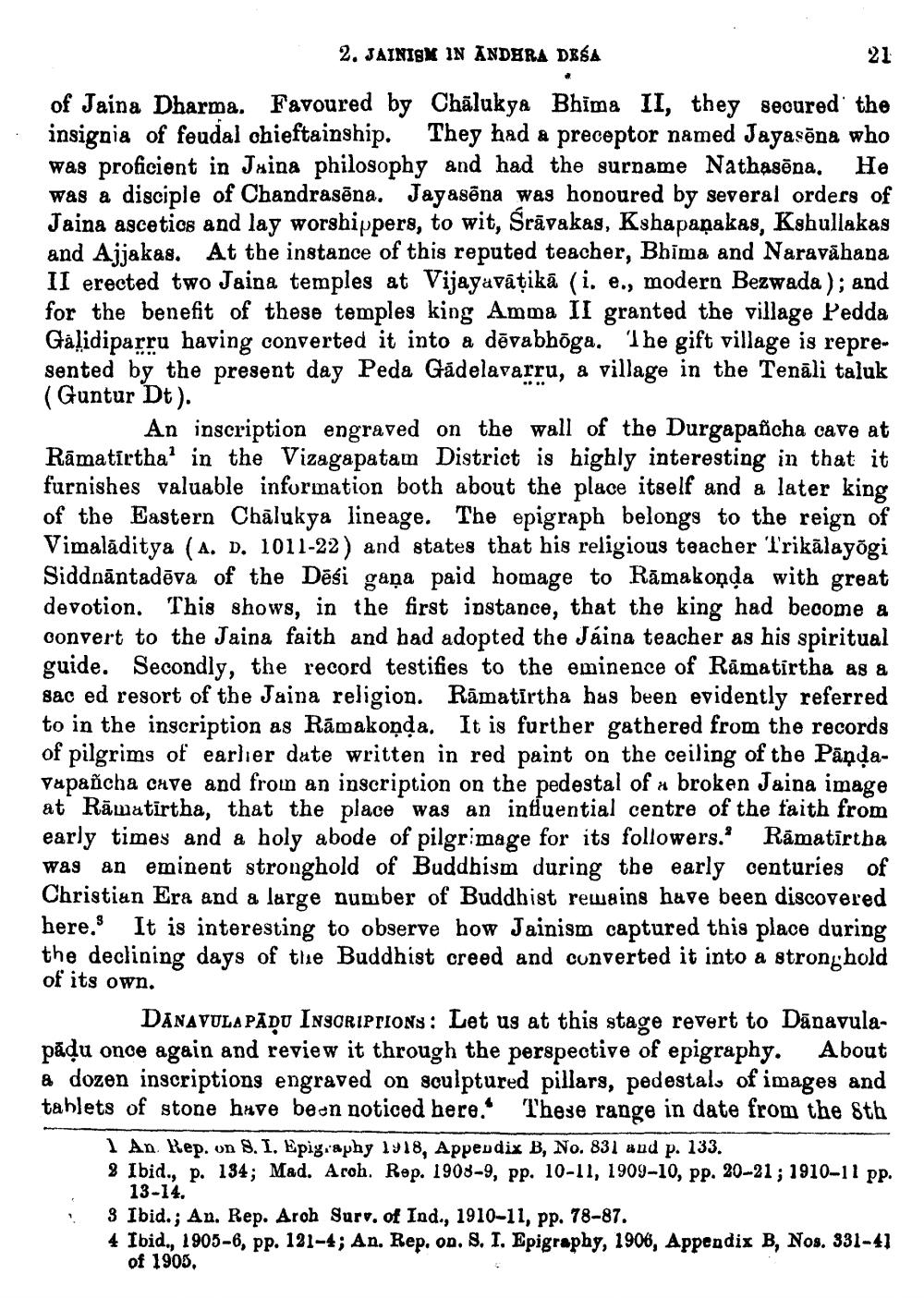________________
2. JAINISM IN ANDERA DESA
21 of Jaina Dharma. Favoured by Chalukya Bhima II, they secured the insignia of feudal chieftainship. They had a preceptor named Jayasēna who was proficient in Juina philosophy and had the surname Nathasēna. He was a disciple of Chandrasēna. Jayasõna was honoured by several orders of Jaina ascetics and lay worshippers, to wit, Srāvakas, Kshapanakas, Ksbullakas and Ajjakas. At the instance of this reputed teacher, Bhima and Naravāhana II erected two Jaina temples at Vijayavātikā (i. e., modern Bezwada); and for the benefit of these temples king Amma II granted the village Pedda Galidiparru having converted it into a dēvabhöga. The gift village is represented by the present day Peda Gādelavarru, a village in the Tenāli taluk (Guntur Dt).
An inscription engraved on the wall of the Durgapascha cave at Rāmatirtha' in the Vizagapatam District is highly interesting in that it furnishes valuable information both about the place itself and a later king of the Eastern Chālukya lineage. The epigraph belongs to the reign of Vimalāditya (A. D. 1011-22) and states that his religious teacher Trikālayõgi Siddnāntadēva of the Dēsi gana paid homage to Rāmakonda with great devotion. This shows, in the first instance, that the king had become a convert to the Jaina faith and bad adopted the Jáina teacher as his spiritual guide. Secondly, the record testifies to the eminence of Rāmatirtha as a sac ed resort of the Jaina religion. Rāmatirtha has been evidently referred to in the inscription as Rāmakonda. It is further gathered from the records of pilgrims of earlier dute written in red paint on the ceiling of the PāņqaVapañcha cave and froin an inscription on the pedestal of a broken Jaina image at Rāmatirtha, that the place was an intluential centre of the faith from early times and a holy abode of pilgrimage for its followers. Rāmatirtha was an eminent stronghold of Buddhism during the early centuries of Christian Era and a large number of Buddhist rewains have been discovered here. It is interesting to observe how Jainism captured this place during the declining days of the Buddhist creed and converted it into a stronghold of its own.
DANAVULAPĀŅU INSCRIPTIONS: Let us at this stage revert to Dānavulapādu once again and review it through the perspective of epigraphy. About & dozen inscriptions engraved on sculptured pillars, pedestals of images and tablets of stone have been noticed here. These range in date from the Sth
1 An Rep. un 8. 1. Epigraphy 1918. Appendix B, No. 831 and p. 133. 2 Ibid., p. 134; Mad. Aroh. Rep. 1908-9, pp. 10-11, 1909-10, pp. 20-21; 1910-11 pp.
13-14, 3 Ibid. ; An. Rep. Aroh Surv. of Ind., 1910-11, pp. 78-87. 4 Ibid., 1905-6, pp. 121-4; An. Rep. on. S. I. Epigraphy, 1906, Appendix B, Nos. 331-41
of 1905.




